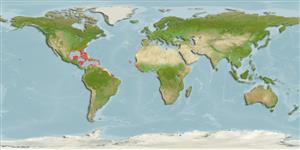>
Gobiiformes (Gobies) >
Gobiidae (Gobies) > Gobionellinae
Etymology: Gnatholepis: Greek, gnathos = jaw + Greek,lepis = scale (Ref. 45335).
More on author: Jordan.
Environment: milieu / climate zone / depth range / distribution range
पारिस्थितिकी
समुद्री प्रवाल-भित्ति संयुक्त; गहराई सीमा 0 - 50 m (Ref. 5299), usually 1 - 36 m (Ref. 92171). Tropical; 43°N - 2°S
Atlantic: southern Florida, North Carolina, the Bahamas, Bermuda through to the Lesser Antilles in western Atlantic; also in the oceanic islands of Ascension, Madeira and St Helena, and Sao Tome Island, Cape Verde Islands and the Canary Islands in the eastern Atlantic.
आकार / वज़न / Age
Maturity: Lm ? range ? - ? cm
Max length : 8.2 cm TL पुल्लिंग / अलिंग; (Ref. 39517); 5.7 cm TL (female)
पृष्ठीय रीढ़ (सम्पूर्ण): 7; पृष्ठीय सौफट रेज़ (सम्पूर्ण): 10-12; गुदा कांटा 1; ऐनल सौफट रेज़: 11. Distinguished by the following characteristics: moderately large Gnatholepis (up to 58 mm SL) with nape midline scales always cycloid and most of predorsal scales cycloid; body pale with 6-8 rows of staggered dark brown spots, mid-lateral spots may be largest; transverse black line on the upper part of the eye joining somewhat oblique to curved black line or bar crossing cheek and ending well behind end of jaw; third to fourth first dorsal fin spines longest, fin with square to rectangular appearance when extended; second dorsal and anal fin rays usually I,11; pectoral rays 16-18, usually 17; lateral scales 26-29, usually 27; 9-11 predorsal scales (usually 10), all cycloid (Ref. 92171).
Inhabits open sand, rock, and rubble areas. Often occurs with the bridled goby, Coryphopterus glaucofraenum. Feeds on organisms and organic material by taking sand into its mouth and expelling it through the gill openings, filtering out its food in the process (Ref. 26938).
Life cycle and mating behavior
परिपक्व अवधि | पुनरुत्पत्ति | मछलीऔ का अंडे देना | अंडे | Fecundity | लार्वा
Robins, C.R. and G.C. Ray, 1986. A field guide to Atlantic coast fishes of North America. Houghton Mifflin Company, Boston, U.S.A. 354 p. (Ref. 7251)
IUCN Red List Status (Ref. 130435)
Threat to humans
Harmless
Human uses
जलजीवालय: व्यापारिक
अधिक जानकारी
आम नामउपशब्दचपायचयपरभक्षीईकोटोकसीकोलौजीपुनरुत्पत्तिपरिपक्व अवधिमछलीऔ का अंडे देनाSpawning aggregationFecundityअंडेEgg development
संदर्भजलीयकृषिजलीयकृषि रूपरेखाखींचआनुवंशिकीElectrophoresesहैरेटिबिलटीबीमारीप्रक्रमणNutrientsMass conversion
साधन
Special reports
Download XML
इंटरनेट स्रोत
Estimates based on models
Preferred temperature (Ref.
123201): 23.5 - 28, mean 26.5 °C (based on 290 cells).
Phylogenetic diversity index (Ref.
82804): PD
50 = 0.5010 [Uniqueness, from 0.5 = low to 2.0 = high].
Bayesian length-weight: a=0.00871 (0.00465 - 0.01631), b=3.19 (3.02 - 3.36), in cm total length, based on LWR estimates for this species & (Sub)family-body (Ref.
93245).
Trophic level (Ref.
69278): 2.3 ±0.2 se; based on diet studies.
लौटाव (Ref.
120179): ऊंचा, न्यूनतम जनसंख्या दुगनी समय अवलागत 15 महीने। (Preliminary K or Fecundity.).
Fishing Vulnerability (Ref.
59153): Low vulnerability (10 of 100).
Nutrients (Ref.
124155): Calcium = 145 [76, 299] mg/100g; Iron = 0.966 [0.480, 1.800] mg/100g; Protein = 18 [16, 20] %; Omega3 = 0.145 [0.067, 0.263] g/100g; Selenium = 27 [14, 56] μg/100g; VitaminA = 110 [28, 389] μg/100g; Zinc = 2.52 [1.66, 3.76] mg/100g (wet weight);
